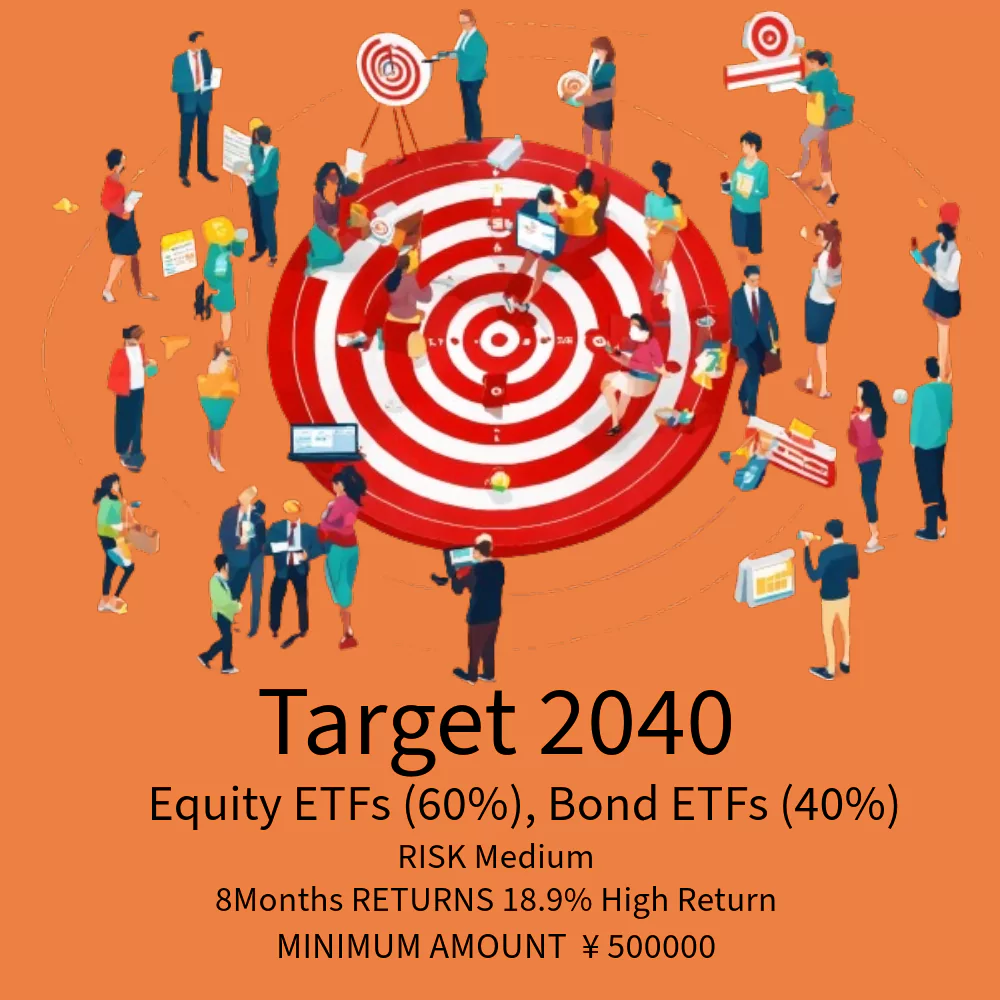Target 2040 New
¥500000
In stock
Asia
Target 2040 - Equity ETFs (60%), Bond ETFs (40%)
RISK
Medium
8Months RETURNS
18.9% High Return
MINIMUM AMOUNT
¥ 500000
Basket Details
Target baskets are for investors who are planning to save and invest for a big expense, be it buying a car, paying for college or retiring around a set target year.
In target baskets, the equity allocation decreases, and the debt allocation increases as the target year comes closer.
The objective of the basket is to accumulate wealth in the initial years and to protect the investment as the target year comes closer. To achieve this, target baskets have higher equity allocation in the beginning to get higher returns, as equities beat debt over the long term in terms of returns.
However, in the short term, this may not hold true since equity investments are more volatile. To adjust for this, target baskets’ debt allocation rises quickly as the target year comes closer - especially for the final four years. This protects the money investors have saved over the entire time frame.
The basket is rebalanced yearly in April, and debt to equity allocation is changed accordingly.
Equity segment ETFs - Nippon India ETF Nifty Next 50 Junior BeES and Nippon India Nifty 50 Bees ETF
Debt segment ETF - BHARAT Bond ETF
Asset allocation breakdown for Target 2040 Basket
| Year | Years to Target | Equity | Debt |
|------|-----------------|--------|------|
| 2023 | 17 | 60% | 40% |
| 2024 | 16 | 58% | 42% |
| 2025 | 15 | 56% | 44% |
| 2030 | 10 | 47% | 53% |
| 2035 | 5 | 33% | 67% |
| 2036 | 4 | 29% | 71% |
| 2037 | 3 | 23% | 77% |
| 2038 | 2 | 17% | 83% |
| 2039 | 1 | 12% | 88% |
| 2040 | 0 | 8% | 92% |
Note: The table shows equity and debt allocation in an interval of five years and the final four years of the target basket. However, the basket is rebalanced every year in April and the asset allocation is changed accordingly
Why this basket?
This basket is for investors who are planning for an expense by 2040. The basket is built to minimize risk, and gradually increases the investment in lower-risk debt as the investor draws closer to the target year.
Who is this basket for?
This basket is for investors saving with a set target year in mind. The basket minimizes risk while distributing investments between equity and debt ETFs. Debt and equity allocation will change depending on the distance to the target year.
RISK
Medium
8Months RETURNS
18.9% High Return
MINIMUM AMOUNT
¥ 500000
Basket Details
Target baskets are for investors who are planning to save and invest for a big expense, be it buying a car, paying for college or retiring around a set target year.
In target baskets, the equity allocation decreases, and the debt allocation increases as the target year comes closer.
The objective of the basket is to accumulate wealth in the initial years and to protect the investment as the target year comes closer. To achieve this, target baskets have higher equity allocation in the beginning to get higher returns, as equities beat debt over the long term in terms of returns.
However, in the short term, this may not hold true since equity investments are more volatile. To adjust for this, target baskets’ debt allocation rises quickly as the target year comes closer - especially for the final four years. This protects the money investors have saved over the entire time frame.
The basket is rebalanced yearly in April, and debt to equity allocation is changed accordingly.
Equity segment ETFs - Nippon India ETF Nifty Next 50 Junior BeES and Nippon India Nifty 50 Bees ETF
Debt segment ETF - BHARAT Bond ETF
Asset allocation breakdown for Target 2040 Basket
| Year | Years to Target | Equity | Debt |
|------|-----------------|--------|------|
| 2023 | 17 | 60% | 40% |
| 2024 | 16 | 58% | 42% |
| 2025 | 15 | 56% | 44% |
| 2030 | 10 | 47% | 53% |
| 2035 | 5 | 33% | 67% |
| 2036 | 4 | 29% | 71% |
| 2037 | 3 | 23% | 77% |
| 2038 | 2 | 17% | 83% |
| 2039 | 1 | 12% | 88% |
| 2040 | 0 | 8% | 92% |
Note: The table shows equity and debt allocation in an interval of five years and the final four years of the target basket. However, the basket is rebalanced every year in April and the asset allocation is changed accordingly
Why this basket?
This basket is for investors who are planning for an expense by 2040. The basket is built to minimize risk, and gradually increases the investment in lower-risk debt as the investor draws closer to the target year.
Who is this basket for?
This basket is for investors saving with a set target year in mind. The basket minimizes risk while distributing investments between equity and debt ETFs. Debt and equity allocation will change depending on the distance to the target year.
Target 2040 - Equity ETFs (60%), Bond ETFs (40%)
RISK
Medium
8Months RETURNS
18.9% High Return
MINIMUM AMOUNT
¥ 500000
Basket Details
Target baskets are for investors who are planning to save and invest for a big expense, be it buying a car, paying for college or retiring around a set target year.
In target baskets, the equity allocation decreases, and the debt allocation increases as the target year comes closer.
The objective of the basket is to accumulate wealth in the initial years and to protect the investment as the target year comes closer. To achieve this, target baskets have higher equity allocation in the beginning to get higher returns, as equities beat debt over the long term in terms of returns.
However, in the short term, this may not hold true since equity investments are more volatile. To adjust for this, target baskets’ debt allocation rises quickly as the target year comes closer - especially for the final four years. This protects the money investors have saved over the entire time frame.
The basket is rebalanced yearly in April, and debt to equity allocation is changed accordingly.
Equity segment ETFs - Nippon India ETF Nifty Next 50 Junior BeES and Nippon India Nifty 50 Bees ETF
Debt segment ETF - BHARAT Bond ETF
Asset allocation breakdown for Target 2040 Basket
| Year | Years to Target | Equity | Debt |
|------|-----------------|--------|------|
| 2023 | 17 | 60% | 40% |
| 2024 | 16 | 58% | 42% |
| 2025 | 15 | 56% | 44% |
| 2030 | 10 | 47% | 53% |
| 2035 | 5 | 33% | 67% |
| 2036 | 4 | 29% | 71% |
| 2037 | 3 | 23% | 77% |
| 2038 | 2 | 17% | 83% |
| 2039 | 1 | 12% | 88% |
| 2040 | 0 | 8% | 92% |
Note: The table shows equity and debt allocation in an interval of five years and the final four years of the target basket. However, the basket is rebalanced every year in April and the asset allocation is changed accordingly
Why this basket?
This basket is for investors who are planning for an expense by 2040. The basket is built to minimize risk, and gradually increases the investment in lower-risk debt as the investor draws closer to the target year.
Who is this basket for?
This basket is for investors saving with a set target year in mind. The basket minimizes risk while distributing investments between equity and debt ETFs. Debt and equity allocation will change depending on the distance to the target year.
0 Comments
0 Shares
14476 Views






